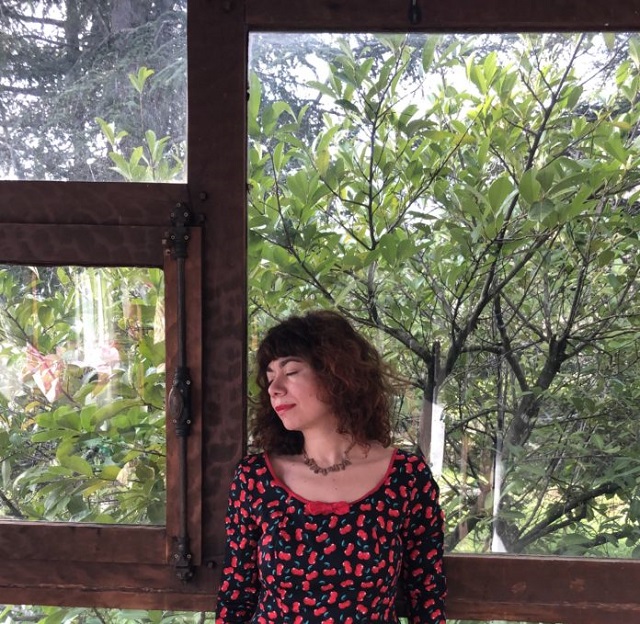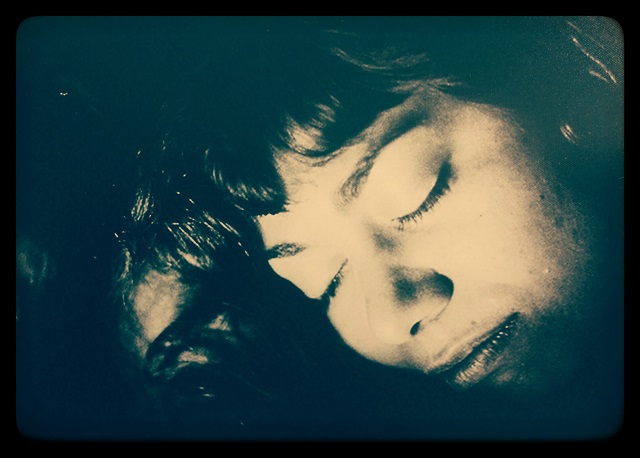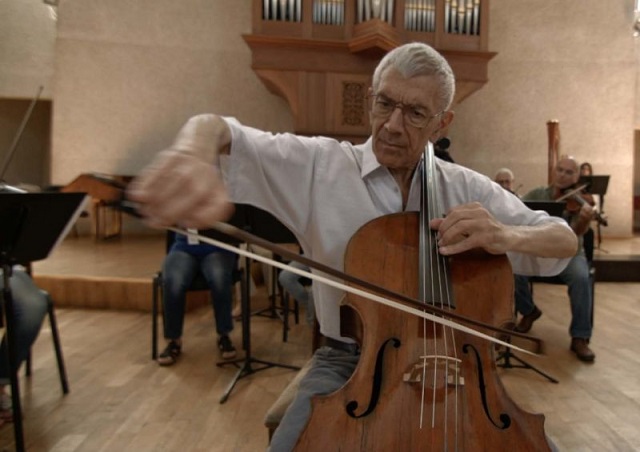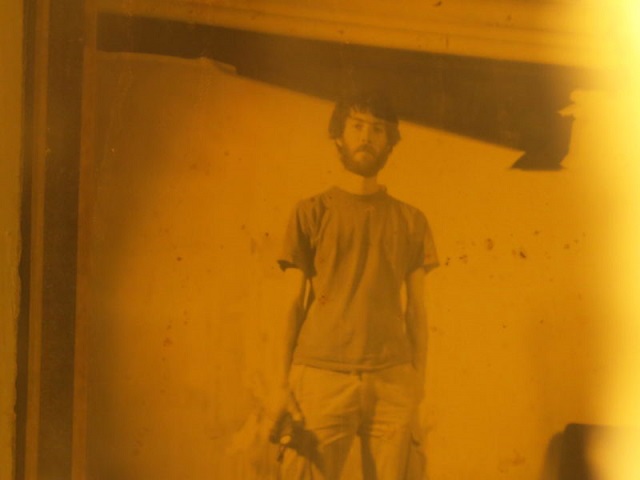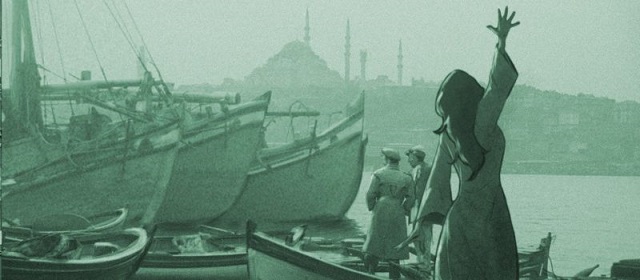by Aram Arkun
PARIS – French-Armenian Anahit Simonian is a creative polymath, performing on the piano in various genres, composing music and writing film scripts, while moving back and forth between Spain and France each year. This year she was chosen to participate in the Berlinale Talents of the Berlin International Film Festival. She says that this week, she is really enjoying it, having meetings with filmmakers like Apichapong Weerasethakul (Thailand) or Mohammad Rasoulof from Iran.
Born in Yerevan, she presciently declared somewhere between the ages of four and eight years that she would one day live in Paris and become a filmmaker, Simonian said in an interview with the Mirror-Spectator.
When she was 20, she entered the “Mozart du 7ème Art” prize created by CANAL+ at the 2000 Cannes Film Festival, a competition for music for a movie, by chance, she said. She won, but it took a lot of effort. After also winning during the same year a SACEM (Société des auteurs, compositeurs et éditeurs de musique) prize and the Sony Music Special Prize for Young Composers, she went on to write over 25 original soundtracks for films, collaborating with well known filmmakers such as Bertrand Tavernier, Isaki Lacuesta, Jean-Bernard Marlin and Meritxell Colell.
Making Music Like Drinking Water
Her parents are both professional musicians, with her father Felix a composer, cellist and member of the famous Komitas Quartet, and her mother a doctor of musicology (and also of psychology). As a teenager, she moved to Moscow with her family for two years. Then she went to Paris to finish her conservatory studies and stayed there some 12 or 14 years.
She said she became tired of the rainy weather and wanted to explore the south. She met her husband Guillaume Poussou, who is a French photographer, in Barcelona. Both of them have various artistic projects, in France, Spain and Switzerland, and sometimes also work together. Simonian said, “We are very lucky because this is possible, and we have good artist friends with whom we can do projects.”
With her family background, she said, “I began to play music because it was very easy. Music was a part of my life just as much as water to drink. I didn’t even ask why music is there.” She studied music in Armenia, Moscow and Paris.
She composed music from childhood, completing her first composition at the age of three or four. She began to compose and play professionally from the age of nine or ten, and used to play a lot of concerts with her father Felix. She studied classical piano but she always worked on improvisations too. She collaborated as pianist and composer with various musicians such as Stefan Baumann, Greg Cohen and Henry Texier.
Simonian was always very eclectic when composing. She said, “I like to explore different fields of sound creation. I have some creations for contemporary music, folk, jazz and classical orchestra.”
Filmwriting
In parallel with her musical development, Simonian was already writing scripts for the theater from childhood. Around seven years ago, Simonian said she felt she really wanted to work in film. She said, “Sometimes I need to cook to express myself, and this is one more way to express important things. There are stories I want to tell and things I want to share and shadows I want to film. So I began to write a script and make films.”
She confessed, “I am not a script writer. I am an autodidact. Maybe that helps me to be more free because sometimes I don’t know the rules.” She usually writes scripts in French, but sometimes also has written scripts in Spanish.
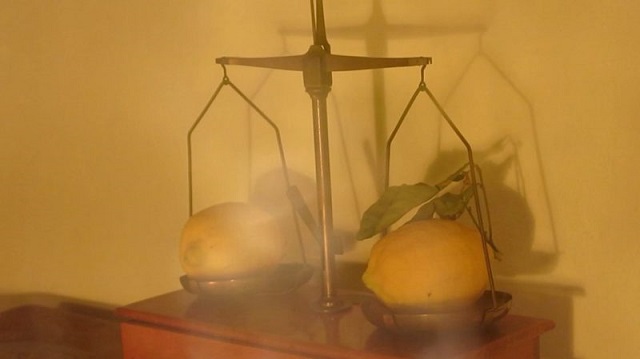
Image from “The ABCs of Being in Love with a Photographer” (Anahit Simonian director, composer, screenwriter, sound designer, co-producer)
She is interested in the liminal, the space between real and imaginary, visible and invisible, so she tries to mix the real and invented in her works.
This is true even when she works on documentaries. For example, she is preparing a film on homeschooling, moved by the experience of homeschooling her own children. Her focus is what would be the perfect dream or ideal homeschooling.
She said that it is a political film in some ways. “It is a reflection on what school means today, how we can do it better and adapt to the new reality.” What makes it deeper in significance is that she asks children what they really need. She said, “In French schools, most of the time, they never ask children what they want or need. My strength is to say, what could be the alternative, the dream. So I film different children, like my son and others, and ask them. I try to create a part where they try to imagine a situation in which all adults leave for two months. How would they construct a school among themselves? We need a dream from which we can construct reality…It is not about homeschooling alone, but how to construct our future society.”
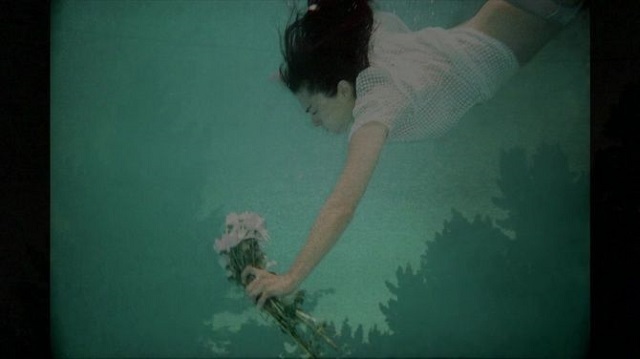
Screenshot from “Transoceanic Letters,” a 2020 creative documentary film directed by Meritxell Colell, for which Simonian was composer
Simonian is not interested particularly in commercial acclaim. She said, “I cannot know what I will do later, but right now it is not that important to be in the industry. I was just speaking with my partner this morning, saying some projects we do for only 100 people, and others for 100,000 or even 1,000,000, but all are in the same place for me. If the project I make can help make life better for one hour for 100 people, it is so precious and that is great. If another project can go to more people and be shared, that is great too.”
She said she only wants to be happy and “my happiness is in its place when I am trying to share something, with my dreams, and if it works, it is wonderful.”
At the same time, she said, “I like simplicity in things. It is very important that a project can reach different kinds of people, not just a specific audience with a certain cultural level.”
She said that she was always looking to keep the balance between all her fields of endeavors. For the last one-and-one-half years, however, she was not able to give concerts, but fortunately, she said, she could still work in other ways.
Armenian Projects and Background
Simonian has done several Armenian-themed composition projects. She had received a commission from Arte France to write the score for a long silent movie. In the beginning, Arte wanted a Russian movie but she suggested an Armenian one, “Namous.” Arte renovated the film to make it look like new, and she suggested doing the recording of the music in Armenia.
Simonian said that it would have been easier for her to do it in France but it was an opportunity to bring work to Armenian musicians and for her to discover new people there. She said, “It was a beautiful experience for me with the musicians. It was so inspiring, so professional, that I was really very happy to do this.” The soundtrack included classical instruments, jazz and three traditional Armenian ones.
With her new composition, “Namous” came out in 2005 and people in France were able to hear the musicians’ talented work, she said.
Simonian worked with director Serge Avedikian and composed music for some of his documentaries. On his initiative, she rewrote the music for the “Anoush” opera by Armen Tigranian entirely. Avedikian meanwhile rewrote the libretto, attempting to restore more original text by Hovhannes Tumanyan. She said that they were only able to recover a few pages of the original score, so instead, “I tried to imagine his mentality. It is not a Stalinist one.” This project was carried out in France and Armenia.
She is also going to work with Avedikian on another one of his films, this time animated, called “Last Round in Istanbul.” It involves a Turkish boxer and an Armenian boxer in 1946. If covid-19 conditions permit, it will hopefully be realized next year. She said, “The new film script is marvelous. It is very interesting how he is speaking about genocide. He found a very interesting and universal point of view.”
Simonian said, “I would like to work more with Armenians. He [Avedikian] is the one Armenian who called me to work.”
She remarked that her father’s side is originally from Kars and Erzurum, and was forced to leave due to the Armenian Genocide. Her grandfather was put in an orphanage in Armenia and his family only found him two years later. Her mother’s family, on the other hand, comes from Shushi in Karabakh.
Simonian said, “It is important for me to go to Shushi to show my children this incredible air and energy. I went twice as a child and I remember it to be a paradise. Going to the forests, you can see everything, and everything is flowing.” She said she is optimistic about the current political situation there but accepts that at least for a few years she cannot bring her children to the place her great-grandfathers were born and married and died.
‘The Fifth String’
As an Armenian, though living in Europe, she said, “I am very influenced by Armenia before Christianity.” She also is interested in Grigor Naregatsi, as an example of a poet, philosopher and even mathematician, perhaps even more than in the pagan Armenian heritage. She said that as a child in Armenia, “going to church was to find a place of silence, a moment you can be with yourself. Some came to pray but others had this intention to find a special place where you can feel better….I feel very close to the Armenian Church. It gives you the possibility to find your own way to believe and to find a connection.”
Simonian said that she is interested in old civilizations because “I am interested in how we lost harmony on earth and how we can find it again. Of course there are no simple answers, but it is important to think about this for everybody. I ask myself what I can do for my small place in the universe, and one of my answers – because I have a lot of answers and more questions than answers – is music.”
She has written a script for a new film, “The Fifth String,” which posits that “the world is out of tune, like a musical instrument,” and explores, she said, “how we can tune it again, for us and for the earth. Music can tune the world.”
The idea for the film came from her father Felix, who will star in the film. She asked whether he had any dreams left in life he had not realized and he said yes, to play concerts in space. Simonian said, “The answer at the end is not really to go up there to play but more to find your own cosmos. Your own cosmos is there when you are in harmony with yourself and the rest of the planet and life.”
Her father is writing most of the music for the film, which is very influenced by Armenian medieval melodies of the 5-8th centuries. Anahit Simonian said, “It is very powerful, this echo from that time, from a time when we were closer to nature and knew better how to live in harmony.” She also will compose some music, primarily filler, for the film.
As this film is still in the early development stage, she is looking for partners. There is already a very good Spanish producer, she said, and a French one is being sought. The film begins in Armenia and ends in Armenia, but it passes through Mexico, Italy and even Siberia, if the budget will allow it. American partners are also helpful, as there will be a portion filmed in the US.
Teaching, Publishing, Bringing Together the Generations, Writing
Simonian teaches in cinema in a high school, a fine arts school, and a university in Barcelona. She said that she is invited to each place for a workshop or master class for one or two weeks usually, with the longest stint being three months. This gives her flexibility. She said, “So when I come up with an idea of constructing scripts or sounds, I have all my freedom.”
She and her husband run a project called the Invisible Travel Agency. Today there are a bit less than 100 members. She said this is a philosophy of life and perhaps also a joke that we all we do are invisible travels. In Barcelona they had a very big art working space so they invited artists once or twice a month to share their films, music and art in a very underground and informal way. Due to the novel coronavirus, starting last year periodic virtual meetings were held instead of physical ones.
The idea was to bring together younger artists with older generations of creative people. It allowed a lot of people who could not afford to pay for certain work to help one another and exchange their services as if it was a collective.
It also includes a publishing arm in order to be able to publish books or audiovisual projects, mostly short format video. Sometimes it is interdisciplinary, she said, and they edit everything together. There are both digital and physical versions. “We like that and think it is important to defend the physical format,” she said.
Aside from scripts, Simonian has written some short stories and poetry. She hasn’t published the stories but can use the poetry with her songs. Most recently she began to write a book with Spanish journalist and writer Ivan Pinto. “It is about the creative process and where it begins, and how to find a way to the inner world.” It discusses what kind of creativity can make people feel in harmony. She said it is based on their experiences and that of their colleagues and students, and for now, the project is called “Inner Mirror.”
Aside from her many projects, she is helping her husband and partner in his work to construct the “Time Machine,” which she says is “a way to reinvent memory and travel to another time, maybe to another dimension.” Her husband is also a visual artist making installations, video art and sculptures. He is developing his ideas with people who work with technology in order to put sounds and images from our memory into this machine and thus travel through our memories. Simonian said, “It is more of a philosophical construct, and it was our son Tigran’s idea.”




















































